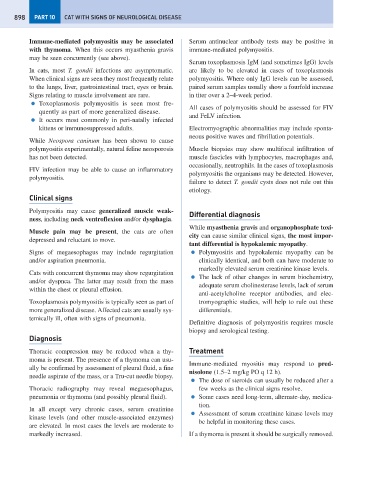Page 906 - Problem-Based Feline Medicine
P. 906
898 PART 10 CAT WITH SIGNS OF NEUROLOGICAL DISEASE
Immune-mediated polymyositis may be associated Serum antinuclear antibody tests may be positive in
with thymoma. When this occurs myasthenia gravis immune-mediated polymyositis.
may be seen concurrently (see above).
Serum toxoplasmosis IgM (and sometimes IgG) levels
In cats, most T. gondii infections are asymptomatic. are likely to be elevated in cases of toxoplasmosis
When clinical signs are seen they most frequently relate polymyositis. Where only IgG levels can be assessed,
to the lungs, liver, gastrointestinal tract, eyes or brain. paired serum samples usually show a fourfold increase
Signs relating to muscle involvement are rare. in titer over a 2–4-week period.
● Toxoplasmosis polymyositis is seen most fre-
All cases of polymyositis should be assessed for FIV
quently as part of more generalized disease.
and FeLV infection.
● It occurs most commonly in peri-natally infected
kittens or immunosuppressed adults. Electromyographic abnormalities may include sponta-
neous positive waves and fibrillation potentials.
While Neospora caninum has been shown to cause
polymyositis experimentally, natural feline neosporosis Muscle biopsies may show multifocal infiltration of
has not been detected. muscle fascicles with lymphocytes, macrophages and,
occasionally, neutrophils. In the cases of toxoplasmosis
FIV infection may be able to cause an inflammatory
polymyositis the organisms may be detected. However,
polymyositis.
failure to detect T. gondii cysts does not rule out this
etiology.
Clinical signs
Polymyositis may cause generalized muscle weak-
Differential diagnosis
ness, including neck ventroflexion and/or dysphagia.
While myasthenia gravis and organophosphate toxi-
Muscle pain may be present, the cats are often
city can cause similar clinical signs, the most impor-
depressed and reluctant to move.
tant differential is hypokalemic myopathy.
Signs of megaesophagus may include regurgitation ● Polymyositis and hypokalemic myopathy can be
and/or aspiration pneumonia. clinically identical, and both can have moderate to
markedly elevated serum creatinine kinase levels.
Cats with concurrent thymoma may show regurgitation
● The lack of other changes in serum biochemistry,
and/or dyspnea. The latter may result from the mass
adequate serum cholinesterase levels, lack of serum
within the chest or pleural effusion.
anti-acetylcholine receptor antibodies, and elec-
Toxoplasmosis polymyositis is typically seen as part of tromyographic studies, will help to rule out these
more generalized disease. Affected cats are usually sys- differentials.
temically ill, often with signs of pneumonia.
Definitive diagnosis of polymyositis requires muscle
biopsy and serological testing.
Diagnosis
Thoracic compression may be reduced when a thy- Treatment
moma is present. The presence of a thymoma can usu-
Immune-mediated myositis may respond to pred-
ally be confirmed by assessment of pleural fluid, a fine
nisolone (1.5–2 mg/kg PO q 12 h).
needle aspirate of the mass, or a Tru-cut needle biopsy.
● The dose of steroids can usually be reduced after a
Thoracic radiography may reveal megaesophagus, few weeks as the clinical signs resolve.
pneumonia or thymoma (and possibly pleural fluid). ● Some cases need long-term, alternate-day, medica-
tion.
In all except very chronic cases, serum creatinine
● Assessment of serum creatinine kinase levels may
kinase levels (and other muscle-associated enzymes)
be helpful in monitoring these cases.
are elevated. In most cases the levels are moderate to
markedly increased. If a thymoma is present it should be surgically removed.

